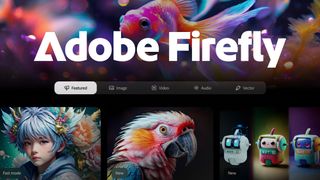10 future design tools you need to know about
Adobe engineers wow audiences at Adobe MAX with an inspiring look into future tech.

A favourite for many at Adobe MAX 2018, Sneaks is the session where audiences get an inspiring and entertaining look into future technology at Adobe.
Hosted in the South Hall of the LA convention centre, it was quite a sight to see the main doors open and MAX attendees quite literally running to the front to find seats. Excitement and anticipation filled the room, and, as the show got underway, it quickly became apparent why.
This year's Sneaks was co-hosted by senior Creative Cloud evangelist Paul Trani and comedian Tiffany Haddish, who came into her own as she helped Trani introduce each project, leaving the audience laughing their way into the next Sneak.
But the real magic came when the Adobe engineers made it to the stage. This year there are some truly outstanding innovations, which were, quite rightly, met by huge appreciation and applause. But before you get too carried away, remember these tools don't exist yet and some might never actually make it into Adobe's shipping software. However, the innovations inform the future product development at the very least, so everything you see here has serious potential.
So, without further ado, here's the MAX Sneaks class of 2018...
Brush Bounty
Sneaks kicked off with Brush Bounty, a new tool that allows users to add simple motion to illustrations using a brush. Impressive in itself, but it didn’t stop there. With Brush Bounty, the motion can be altered depending on a number of variables, including the number of likes a project gets on social media and the weather conditions in a certain country, at a specific time. With Brush Bounty, a smartphone can also be used to control the direction of the animation. Mind blowing stuff.
Project Smooth Operator
Using Adobe Sensei technology, Project Smooth Operator identifies the most interesting parts of video footage and reframes it accordingly. The technology intelligently works out what’s important in the video and crops it to that, so you always have your point of interest in frame. Genius.
Get the Creative Bloq Newsletter
Daily design news, reviews, how-tos and more, as picked by the editors.
Fantastic Fold
Designers everywhere dealing with complex packaging designs rejoice! This Fantastic Fold tool analyses a dieline and automatically determines the folded 3D shape as well as interactive mapping between the 2D and 3D representations. This tool not only bridges the 2D and 3D worlds, it would also mean never again will you design a super-cool box and not have the designs match up when it's folded.
Project Waltz
A mobile companion app, Project Waltz allows you to control 3D virtual cameras more precisely on a 2D surface, with precise and natural camera motions.
Fontphoria
The project that easily got the biggest cheers, Fontphoria uses Adobe Sensei technology to automatically transform a static image into an alphabet or complete set of fonts. It makes modifying text so easy, it's magical.
Project Fast Mask
Rotoscopers beware, there's a new tool (almost) in town. Project Fast Mask is another project utilising Adobe new’s AI technology, with Adobe Sensei accurately identifying an object and applying a mask across multiple frames of a video, making a laborious manual editing process almost automatic.
Project Model Morph
One for the 3D artists among us, Project Model Morph is an intuitive and easy-to-use tool for editing 3D man-made objects. Anyone who works with 3D geometry will know how time-consuming editing thousands, if not millions of polygons can be. Project Model Morph does all the hard work, scaling objects easily and quickly, preserving symmetry, and eliminating distortion.
Moving Stills
Want to animate a photo? The Moving Stills tool animates any image, so that it appears in 3D. Again, using Adobe Sensei technology, Moving Stills uses deep learning to generate videos from a single still, meaning that a job that would usually take hours to achieve can be done in a matter of minutes.
Project Kazoo
Charismatic Adobe engineer Zeyu Jin put on quite a show, impressing the audience with Project Kazoo, another tool using Adobe Sensei magic to effortlessly turn your voice into music.
Project Good Bones
This was another huge crowd pleaser, and seeing as editing vectors can be a complicated process, it's not hard to see why. Project Good Bones enables intuitive and shape-aware editing of complex vector graphics objects via automatically added segment handles and ‘bones’ connecting them, thus creating a skeleton.
Read more:

Thank you for reading 5 articles this month* Join now for unlimited access
Enjoy your first month for just £1 / $1 / €1
*Read 5 free articles per month without a subscription

Join now for unlimited access
Try first month for just £1 / $1 / €1

Kerrie Hughes is a frequent contributor to Creative Bloq, and was once its editor. One of the original CB crew, Kerrie joined the team back in 2013 after moving from her role as staff writer on 3D World. Since then she's written regularly for other creative publications such as ImagineFX, Computer Arts and Digital Camera World. After a stint working for the police, Kerrie is back reviewing creative tech for creative professionals.



